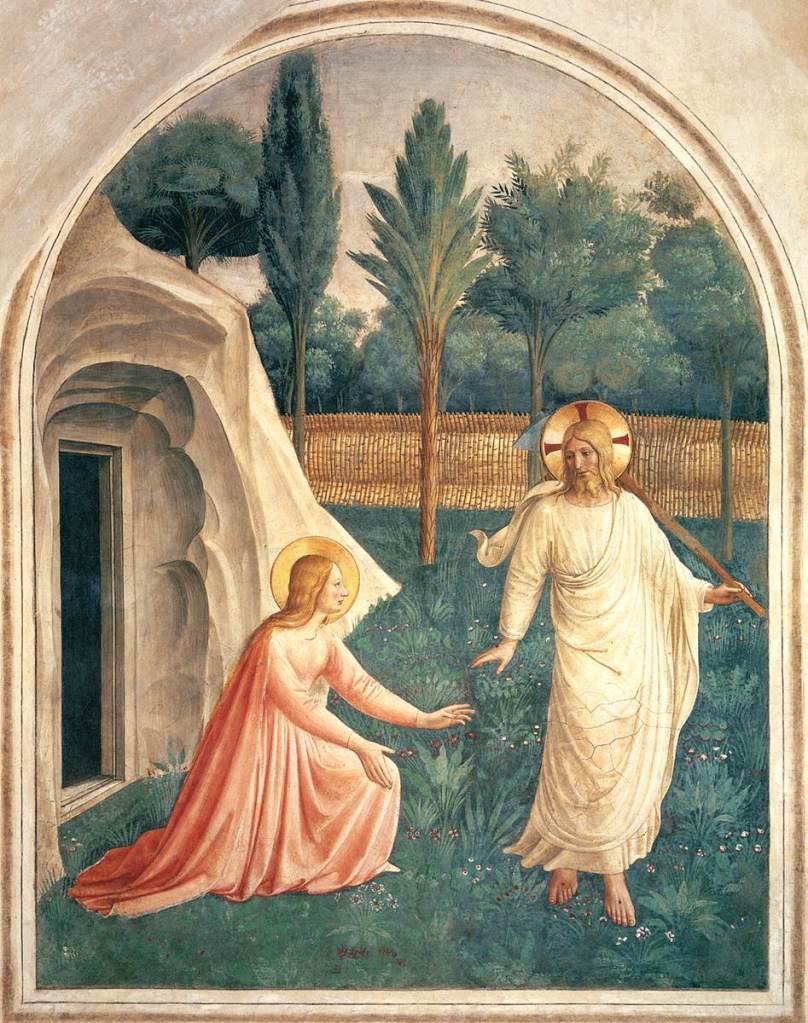Early in the morning, on the first day of the week, something strange and wonderful happened, which has changed the world. It can be hard to imagine quite how disconcerting Jesus’ Resurrection must have been for the Disciples and all who were close to Jesus. Nearly two thousand years later, we are perhaps too familiar with the story of Our Lord’s Resurrection. But, only for a moment, I would like us to try to imagine that we were witnesses to events, as they unfolded. We saw Christ enter Jerusalem, hailed as the Messiah. But, after spending time with His Disciples, and telling them to, ‘Do This in memory of Him’, (something we have come here to do), He was arrested, condemned, and killed. The disciples’ emotions must have been strong: fear, disbelief, questioning: will we be next? Jesus talked about dying, and rising again, but He couldn’t have meant like this, could He?
Mary of Magdala went to the tomb, either to anoint the body properly (there wasn’t time on Friday afternoon), or just spend time at the grave of someone she loved. She sees the stone rolled away, and returns to tell Peter and John,
“They have taken the Lord out of the tomb, and we do not know where they have laid him.” (Jn 20:2)
Mary is concerned with the dead body of Jesus. When Peter and John run to the tomb, John gets there first, he sees the cloths, but doesn’t go into the tomb. Peter goes in and sees everything. Then John goes in, sees and believes.
Mary stays by the tomb, filled with grief. Not only is Jesus dead, but his body has disappeared. Even when angels speak to Mary, all she can say is,
“They have taken away my Lord, and I do not know where they have laid him.” (Jn 20:13)
She sees Jesus, who asks Mary why she is weeping, and who she is looking for. We then have an interesting detail:
Supposing him to be the gardener, she said to him, “Sir, if you have carried him away, tell me where you have laid him, and I will take him away.” (Jn 20:15)
Mary still thinks Jesus is dead. She loves Him, and all she wants to do is to take care of His body. She is a paragon of love, devotion, and service. But it is only when Jesus calls her by name that she recognises Him.
One detail which I find intriguing is that Mary Magdalen supposes that Jesus is the gardener. Gardens and cemeteries had people looking after them, even in 1st century Palestine. But mention of gardens and gardeners makes me think of another passage in the Bible concerned with matters horticultural. In Genesis, God makes a garden, Eden, puts Adam in it, and commands him to look after it (Gen 2:15). The first man is a gardener. The Risen Christ, the New Adam, is seen as a gardener. Whilst the first Adam brought death to humanity by a tree, the Second Adam has brought life to the world, by the tree of the Cross. Humanity falls because of a tree, and because of a tree we are offered eternal life in Christ.
It is the first day of the week, when Creation began, and now on the first day of the week we see a New Creation, as Christ has risen from the dead, conquering death and Hell. Christ is a gardener, and the plants he tends are human. We believe in a God who loves us, who cares for us, and who longs to see us experience the fullness of life. That sounds like the description of a gardener to me: someone who nurtures, who longs to see growth. In His Passion, Christ has overcome the bitter fruit of human disobedience with His own obedience. We are here today, because Christ’s fruit, His Body and Blood has nourished the Church through the centuries, and will continue to do so until He comes in glory.
Over the last year we have experienced the same fear, disbelief and questioning that the Disciples felt. Now we yearn to be filled with the joy, hope, and peace of the Risen Lord. The Resurrection of Jesus is a time for celebration. A time to enjoy all the good fruits of the earth. We rejoice that we can once again gather in each others’ gardens and give thanks for the good weather we have been blessed with this week. So, my brothers and sisters in Christ, ‘Pasg hapus i chi gyd!’ ‘A Happy Easter to you all!’ May you, and those you love, be filled with Resurrection joy and strength, now and always. Amen.

No comments:
Post a Comment